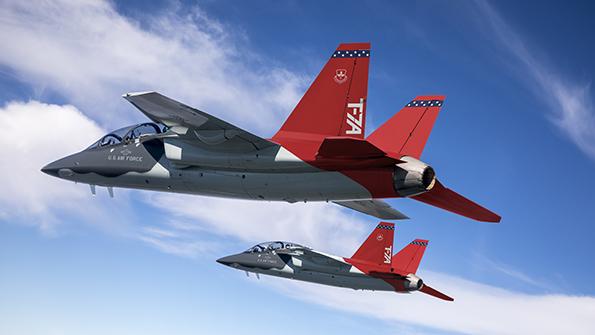
Two fresh proposals by the U.S. Air Force and Navy to buy hundreds of additional jet trainers come with a schedule and list of requirements that seem to rule out aircraft types already in development or operation.
The proposals come with different names: an Advanced Tactical Trainer (ATT) for the Air Force and a Tactical Surrogate Aircraft (TSA) for the Navy.
- Hourly cost target set below $3,000
- Dozens needed for delivery before 2025
But two requests for information submitted in October, one each by both branches of the armed forces, present a nearly identical list of prerequisites, except items unique to the Navy’s carrier operations. The ATT and TSA must be fast (maximum speed: Mach 0.9-1.2), cheap ($2,000-$3,000 hourly operating cost) and ready to be delivered in batches of dozens within four years.
In combination, those requirements seem daunting for the most obvious option: Boeing’s T-7A Red Hawk. As the Air Force’s confirmed replacement for the Northrop T-38C Talon, the T-7A may not have enough spare production capacity for several years—even if the type could somehow meet the requirement for the low-single-digit hourly operating cost.
The T-7A’s competitors in the Air Force’s 2018 T-X contract competition, the Korea Aerospace Industries/Lockheed Martin T-50 and Leonardo M-346, might be more available in the near term. But the latter lacks the required afterburner and both also could struggle with the hourly operating costs. Even Northrop Grumman’s low-cost, all-composite Model 400 Swift—a prototype trainer withdrawn from the T-X competition after seven company-funded flights—would fail the speed and afterburner requirements, topping out at roughly Mach 0.75 with a nonafterburning GE Aviation F404 engine.
Gen. Mark Kelly, the head of Air Combat Command, has acknowledged that the Air Force’s requirements for ATT may not align with an existing jet trainer on the market today.
“Oh, by the way, there could be a different solution out there,” Kelly said, speaking at a Mitchell Institute event on Oct. 25. “But I need something like [a T-7A], and then [it depends on] how fast industry can respond and get us something that’s not $20,000-plus cost per flying hour, but closer to $2,000-$3,000.”
For perspective, the Air Force’s hourly cost target of $3,000 for the ATT aircraft matches the advertised rate for the Textron AirLand Scorpion, but even that aircraft’s Mach 0.7 top speed and lack of afterburners falls short of other needs. Similar challenges also face other low-cost trainers on the market, such as the Aero L-39NG.
The concepts for the Air Force’s ATT and the Navy’s TSA are not new. They are both modeled on an approach adopted by the Italian and Israeli Air Force’s M-346 trainers. Instead of using front-line fighters for most flights in the Air Force’s Formal Training Units or the Navy’s Fleet Replacement Squadrons, the goal is to offload many training or proficiency flights on a significantly cheaper aircraft. The proposals fit within a broader restructuring of the Air Force’s combat squadrons called the Reforge concept.
Despite the low-cost imperative, the Air Force and Navy still want high-performance jets. In addition to the speed and afterburner requirements, the proposed ATT and TSA fleets also require advanced cockpits with zero-zero ejection seats, large-area displays, hands-on throttle-and-stick controls, and provisions to quickly accept sophisticated payloads of sensors, jammers and weapons.
Boeing appeared to anticipate the concept shortly after winning the T-X competition. A Boeing-drafted proposal for a “T-7B” appeared in an April 2020 research paper published by an Air Force pilot in graduate school at Air University. The proposal for the T-7B included an acquisition price of $20.6 million and a cost per flight hour of $7,200, with a first delivery in July 2025. Although significantly lower than any of the Air Force or Navy’s front-line fighters, the T-7B’s proposed costs still greatly exceed the Air Force’s target for ATT.
“It’s not a criticism of the T-7,” Kelly said. “They built what they were designed to build. But it may or may not fit the demand of going from flying to fighting.”






Comments
While those pieces remain, the T-7 is the only bet that has a chance in hell of meeting most of the requirements.
1) an uprated Scorpion with either F124 or F125 engines or
2) a clean sheet design.
The Scorpion may meet the cost/flight hour requirement, but any design is going to struggle to meet the Naval carrier requirements.